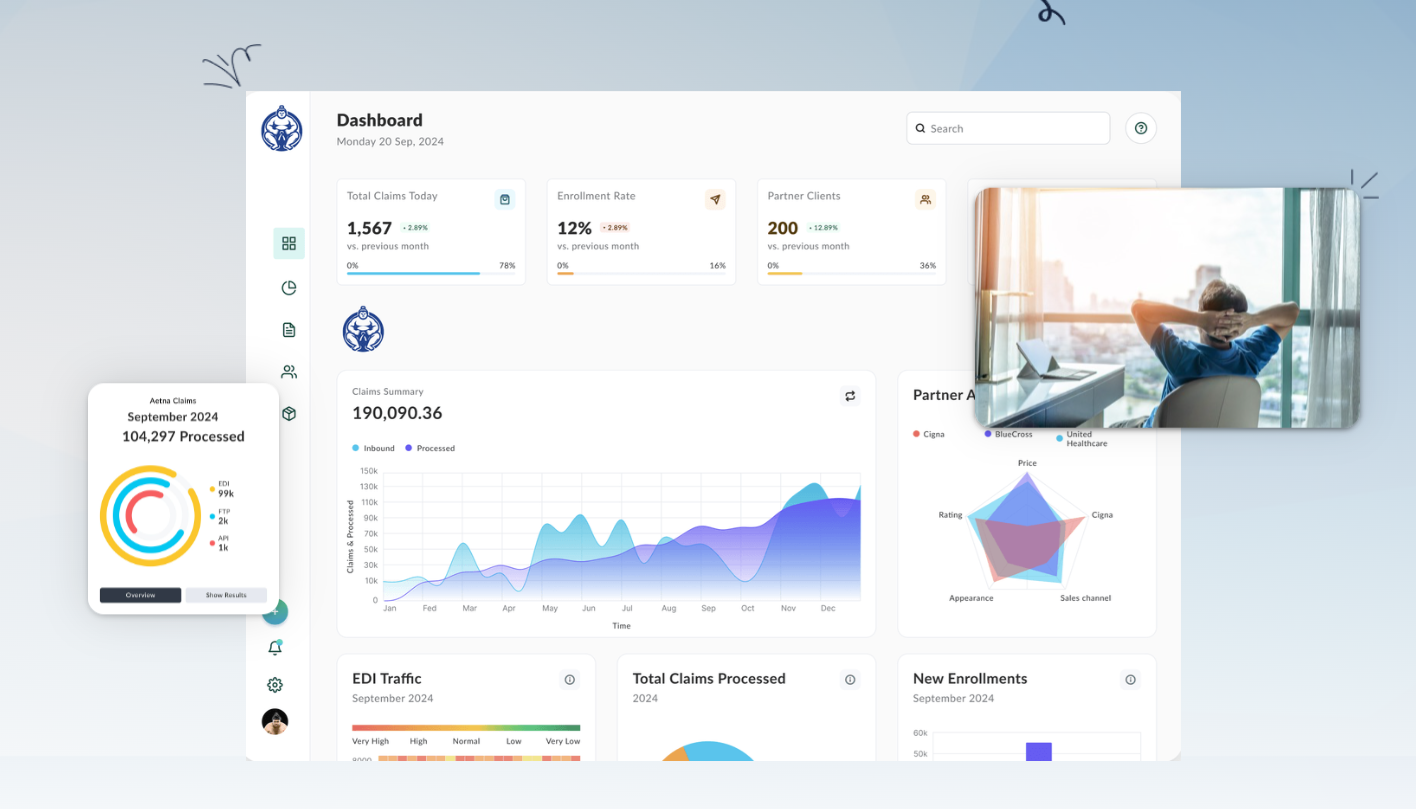From Spreadsheets to Dashboards: Transforming Healthcare EDI Tracking with Real-Time Monitoring


For years, healthcare insurance payers have wrestled with tracking EDI (Electronic Data Interchange) files using spreadsheets, ad hoc custom scripts, and reactive communication between claims, enrollment, and support teams. The promise of EDI data exchange-seamless, fast, and standardized-often gives way to realities: lost files, delayed processing, data discrepancies, and compliance headaches. How did we get here, and more importantly, how do we move toward a future where EDI visibility is real-time and actionable rather than a patchwork of manual effort?
Why Spreadsheets Became the Default EDI Tracking Tool
It's easy to understand why spreadsheets became ubiquitous in EDI tracking:
- Familiarity: Most teams know Excel or Google Sheets, so they default to what they have.
- No Setup Needed: Spreadsheets can be spun up in seconds without IT involvement.
- Flexibility: Users can customize columns, filters, and data views as needed.
But as EDI volume, complexity, and regulatory scrutiny exploded, these sheets showed their cracks-manual updates, version confusion, missed errors, and zero real-time insight hamper every department, especially as files and claims number in the hundreds of thousands or millions.
The Hidden Costs and Risks of Spreadsheet-Based EDI Tracking
Many payers put off modernizing their EDI tracking because their spreadsheet solution “mostly works.” However, in practice, sticking with manual tracking introduces significant downsides:
- Delayed Error Detection: By the time a file mismatch or mapping error is spotted in a spreadsheet, days or weeks may have passed, making remediation more costly.
- No Real-Time Monitoring: SLA breaches, delayed enrollment updates, and missing claims only show up in retrospective reporting, after damage is done.
- Tribal Knowledge: Only a handful of individuals know the quirks of each sheet, risking operational paralysis during vacations or staff turnover.
- Compliance Nightmares: HIPAA and audit requirements around traceability and data integrity become labor-intensive, with every export and manual update increasing potential for error.
- Data Fragmentation: Teams build their own tracking methods, resulting in support silos-claims, enrollment, and customer service rarely share a single EDI view.
What Real-Time EDI Monitoring Looks Like-And Why It Matters
The most transformative leap for payer operations arrives when EDI events, validations, and errors are captured in real time, instantly visible to all relevant teams. Instead of managing EDI as a black box, real-time dashboards bring transparency, proactive issue detection, and collaborative action. At EDI Sumo, real-time monitoring is at the center of our approach.

Key Elements of Modern Real-Time EDI Tracking
- Universal File Format Support: No more separate processes for EDI 834s, CSV, XML, or positional files. The modern stack accepts and normalizes all formats into a single dashboard.
- Instant Alerts: Automated notifications for failed files, mismatched data, compliance flags, and downstream integration issues prevent issues from snowballing.
- Centralized Audit Trails: Every file movement, user action, or update is logged, ensuring both transparency and a reliable paper trail for auditors and compliance teams.
- Role-Based Access: Teams only see the data and workflows relevant to their roles, making dashboards user-friendly and secure.
- Seamless Integration: Real-time monitoring overlays existing claims management and enrollment systems-your IT department doesn’t have to re-platform or disrupt established workflows.
From Exception Handling to Proactive Operations
At EDI Sumo, we’ve witnessed firsthand how shifting from reactive spreadsheet-based tracking to real-time monitoring and dashboards fundamentally transforms insurance operations:
- Support Teams: Instead of waiting for IT to investigate issues, customer service reps can instantly search for member eligibility or claim status, resolving issues on the first call without data lag.
- Compliance Officers: Automated, real-time audit trails and breach monitoring simplify demonstrating HIPAA compliance and reduce anxiety ahead of audits.
- IT Teams: With less time spent firefighting EDI errors, IT can focus on innovation, scalable infrastructure, and delivering more value to the business rather than maintaining fragile legacy scripts.
- Executives: Live performance dashboards provide unfiltered visibility into enrollments, claims, and SLAs-allowing for smarter decisions, accurate forecasting, and peace of mind.
Elements of a Next-Generation EDI Dashboard
Not all dashboards are created equal. Here’s what we believe are essential for unlocking the true power of EDI tracking in healthcare:
- Performance Metrics at a Glance: Visualizations of total processed files, successful transactions, errors, and SLA compliance rates.
- Drill-Down Capabilities: Explore file-level details, view transaction histories, and spot recurring data mapping issues before they escalate into systemic errors.
- Automated Reporting: Easily generate compliance and operational reports-both for internal QA and required partner/trading partner notifications.
- Custom Validation Rules: Go beyond out-of-the-box validations; tailor rules to your business’s unique EDI and data policies (e.g., custom member ID formatting or benefit validation).
Real-World Advantages: Our Perspective from the Trenches
Since we started working with leading healthcare payers, we’ve observed a common pattern: transparency begets collaboration. Departments no longer operate as disconnected silos. Data validation no longer lags days behind source system changes. Most importantly, the risks associated with unsupported formats, mapping quirks, and manual reconciliation are dramatically reduced.
Consider the anxiety around SLA penalties-when real-time dashboards and monitoring are set up effectively, service-level breaches can be anticipated and remedied before they ever result in penalties. In our work, we’ve helped organizations move from a state of constant firefighting to predictable, nearly real-time decision-making. The benefits ripple outward: better data integrity, fewer escalations, lower operating costs, and happier end clients.
Steps to Transforming Your EDI Tracking-Without Starting Over
For payers reading this, you may wonder: "Do we have to rip and replace everything?" The good news is, you don’t. Solutions like EDI Sumo emphasize modular integration, allowing you to:
- Integrate with Your Existing Systems: Beat the pain of legacy lock-in. Connect your claims management or EDI translator systems directly to a centralized dashboard.
- Standardize Input Formats: Bring in EDI, CSV, XML, and other data through a unified pipeline, reducing the need for manual mapping each file batch.
- Set Up Real-Time Alerts: Configure automated notifications for your teams so they’re never caught off guard by avoidable errors or delays.
This incremental approach means minimal disruption to your ongoing operations, while unlocking maximum benefit from your data.
Compliance and Security: More Important Than Ever
With the heightened focus on HIPAA and ever-increasing data breach risks, payers cannot afford ambiguity in their EDI processes. Real-time monitoring and centralized dashboards do more than improve operations-they are now baseline requirements for a defensible, audit-ready compliance posture.
- Data Encryption: Modern solutions, including EDI Sumo, employ robust encryption both in transit and at rest.
- Centralized Audit Logs: Automated, tamper-evident records make audit preparation and incident response dramatically quicker.
- Advanced Access Controls: Role-based access and multifactor authentication keep sensitive insurance data secure and only available to those who need it.
Empowering Business Users – Not Just IT
One of the most exciting changes brought about by real-time EDI dashboards is that business teams can now interact with their data directly. No more waiting days for IT to run custom reports or hunting through endless spreadsheet tabs. With the right tools, support reps, enrollment specialists, and compliance staff have self-service access to what they need, when they need it, improving agility across the board.
Making the Leap: What’s Next?
Moving from spreadsheets to real-time dashboards is about more than adopting new software or automating an old process. It’s about empowering teams across your organization, improving outcomes for your members, and ensuring your business can adapt to continual change-whether that’s regulatory requirements or shifting business needs.
If you’re ready to see how EDI Sumo’s approach can help you move beyond spreadsheets, streamline your EDI tracking, and give your teams the real-time insight they need, schedule a demo with us here.


.png)





.png)

.png)


.png)
